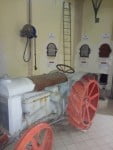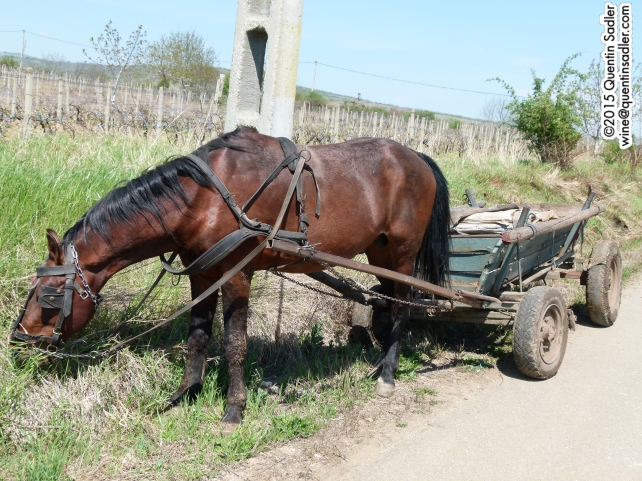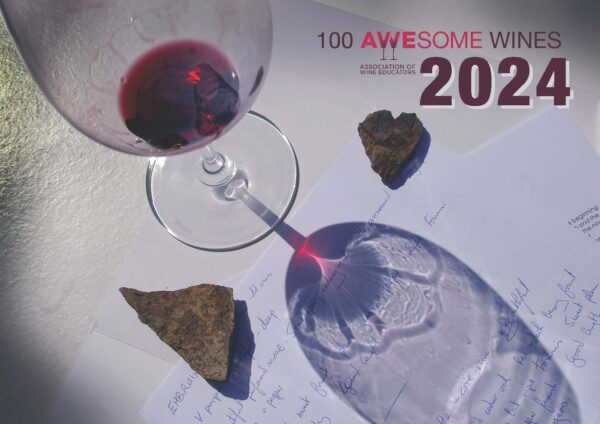It would be impossible to come to Alsace without drinking and enjoying a glass (or several) of Crémant d’ Alsace. While the UK market for this delicious drink remains small, it is the largest selling Crémant in France, accounting for around 50% of domestic sparkling wine sales, (excluding Champagne). There are the 7 Crémant producing regions. In Alsace 500 producers make Crémant, and it accounts for a staggering 25% of all Alsatian wine production. Crémant d’ Alsace is a traditional bottle fermented sparkling wine. The grape varieties should be named on the label, it must be made from healthy whole bunches of grapes to a maximum yield of 100 litres of juice from 150 kilos of grapes. The minimum lees contact is 9 months, although all the houses we encountered exceeded this, and the wine cannot be sold until at least 12 months after bottling.
The house of Dopff au Moulin is the second largest wine company in Alsace, owning 65 ha of vines accounting for 1/3 of their grapes requirement and buying in the remaining 2/3s. They are located in the medieval city of Riquewihr, the house specialises in Crémant d’ Alsace, which accounts for 50% of the 2 million bottle production. The remaining 50% is still wine, with 20% of their Crémant exported. Cuvée Julien brut is the best-selling Crémant d’ Alsace brand on the UK market.
Export manager Philippe Durst emphasises that Crémant is not a by-product of still wine production. Discovering the origins of sparkling wine in Alsace explains the reason, and what makes Dopff au Moulin the obvious choice to visit when studying Crémant d’ Alsace. The story is that in 1900 Julien Dopff discovered the Champagne method at the Universal exhibition in Paris; he was so impressed with the wines that he vowed to take this wine style back to Alsace. Julien then trained for 2 years at Mercier in Champagne before returning to Alsace to bring sparkling wine to region. Pierre Dopff, son of Julien, joined the domain in 1940 and under his guidance the AOP of Crémant d ‘Alsace comes to life in 1976, showing the company’s commitment to this wine style.
As we walk around the production facility we discuss the varieties used, the main varieties being Auxerrois, Pinot Blanc, Pinot Noir, and Chardonnay. Rose can only be made red grapes and here the Pinot Noir is macerated on the skins for 12 hours to produce the rose style. The grapes for Crémant are planted mainly on the flatter land; yields allowed are higher than for still wine at 80hl/ha with the harvest being 2 weeks earlier. Grapes are picked by hand, carefully pressed, with only the free run first fractions used. Ageing on lees at this house varies from 12-15 months for Pinot Blanc and Auxerrois to 22 months for the rose to 36 months for the zero dosage Pinot Blanc/Auxerrois. The wines are riddled in a gyropalette for 2 days before disgorging and dosage addition, with 2 pipes one with wine the other with sugar solution. After dosage the bottles are allowed to rest in the 13C cellar for 4-5 months before shipping.
On to the tasting: the style of the house is finesse and freshness. We started with Cuvée Julien, the largest selling cuvé, which was delicious, crisp and fresh, with hints of floral and citrus a creamy delicate mousse and a spine of acidity with a hint of fresh nuts with the 7gms dosage rounding out the mid palate. This was a blend of the 2012 and 2013, (most NV is a blend of 2 vintages), with the base blend of 50/50 Pinot Blanc and Auxerrois having gone through full MLF, (as is common for white Crémant). The 18 months on lees had imparted subtle brioche notes to the wine. The next Crémant was the Rosé NV with 2 years lees ageing and around 9gms rs. While labelled as non-vintage rosé Crémant here invariably comes from a single vintage. At €10.80 at the property it offers great value for this delicate fresh and fragrant Crémant, packed with flavours of strawberry cream tart, underlined with bright acidity. The base wines for rosé do not go through MLF.
As in all French areas the influence of global warming can be seen, the 2009 vintage yielded very ripe grapes with the base wine for Crémant achieving 13% abv, the base wines were kept in foudre to rest until 2010 when the grapes were picked early at lower potential abv, to compensate for the high alcohols of the previous year.
The tasting becomes more serious as we progress to the Blanc de Noir 2012 aged on lees for 24 months. This wine has a creamy texture and flavours of dried fruit and cherry stones, this is a more serious and vinous wine with structure. This is more of a food wine than the delightful aperitif styles of the preceding wines, and retailing at a great value €11.45.
All in all these wines certainly deliver a price/quality ratio rarely achieved in Champagne, there are, of course, many reasons for this, not least grape cost. Champagne grapes are probably over €6 euros/kilo, while grapes for Crémant in Alsace are around 2.50/kilo euros with Pinot Noir commanding a 20% premium. There is also an organic wine produced using the 4 Pinots, (Noir, Blanc, Gris and Auxerrois) this is an austere, yet rich brut style, with mineral undertones retailing at €12.25.
Not surprisingly the question of the Asian fruit fly (Drosophila suzukii) which was seen across many Northern European vineyards in 2014 came up. This fly causes sour rot which smells of vinegar and renders grapes unusable, crop loss here due to this fly was estimated at 20%, with no respite seen for 2015 vintage due to the warm winter.
While especially known for Crémant 50% of the production of Dopff au Moulin is still wine. Of the 65 ha of vineyards owned, 15 ha are Grand Cru. We finished with the Riesling Grand Cru Schoenenburg 2012 (€47.95) full of lemon pith, slate and minerals rich but underlined with razor acidity.
A sparkling wine tasting is a great way to start the day, and we left refreshed and bubbly, and wondering why, with the current success of sparkling wines in the UK, Crémant d’ Alsace is not more widely appreciated in the UK. Thanks to all at Dopff au Moulin for an informative tasting.
Tags: Alsace Crémant









